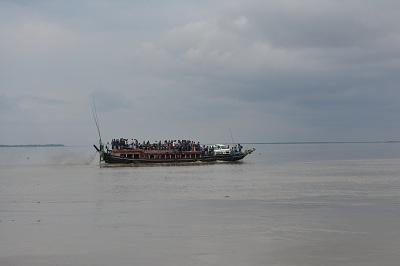The Namami Brahmaputra festival could not have happened at a better time, with rivers around the world in focus, albeit due to varied reasons. The mighty red river of India carries the hopes and aspirations of millions and at the same time, elicits fear and reverence, yet increasing pollution, the will of development planners and the consequences of global warming could transform the Brahmaputra basin. The ‘Son of Brahma’ weaves an increasingly tempestuous course as ‘He’ meanders down the valley, and further intensification of the hydrological cycle due to climate change and planned human interventions could exacerbate the riparian impacts.
Late last year, the United Nations issued a warning about over 323 million people being at risk from the pollution of rivers and lakes. According to the UN Environment Programme report, Cholera, Typhoid and other deadly pathogens are increasing in more than half of the rivers in Africa, Asia and Latin America. An estimated 3.4 million people die each year from these water-borne diseases and half of them are children under the age of five years. Predictable, Asia has been worst hit, with up to 50% of all rivers now affected by severe pathogen pollution caused by a cocktail of untreated waste water disposal, agricultural pesticides run-off and industrial pollution.
Following the historic judgement declaring the Whanganui river as a living entity with full legal rights in New Zealand, the Uttarakhand High Court had decreed that the rivers Ganga and Yamuna, as well as their tributaries are "legal and living entities having the status of a legal person with all corresponding rights, duties and liabilities." The court further elaborated that the order was to ensure "preservation and conservation of the two rivers and to protect the recognition and faith of society." The legal status accorded to the Ganga and the Yamuna means that polluting the water bodies would amount to harming a human being. The court further noted that "the extraordinary situation has arisen since the rivers Ganga and the Yamuna are losing their very existence," alluding to the prevalent disregard for water bodies, which are often treated as dump for garbage and industrial effluents.
The Indian government’s intention to “exploit the hydro-power potential of the Brahmaputra,” while expressing consternation about the dam built by China, is paradoxical. So is the planned river linking project through a network of dams, canals and reservoirs to drain the Brahmaputra and the Ganga to water-deficient areas. This comes at a time when appreciation of the devastating impacts of large dams on people and the environment has forced governments away from the age of dams. According to studies, the threat to World Heritage sites like the Kaziranga and Manas national parks and other sanctuaries in the Brahmaputra valley is not from poachers or encroachers, but from the 70 planned dams and hydel projects upstream and on its tributaries.
Large dams alter and fragment the riverine ecosystem from one that was cold and flowing to a warm and stagnant state, with devastating consequences for wildlife and for people. The World Commission on Dams had warned, back in 2000, that dams were responsible for displacing between 40-80 million people. The Wild and Scenic Rivers Act of 1968 protects more than 12,000 miles of free-flowing rivers in the US and it is now leading the movement to decommission dams and restore rivers to their natural free-flowing state.
Earlier this year, China abandoned plans to build a series of giant hydroelectric dams on the Nuijiang, the last free-flowing river in the country, after a decade long campaign by environmentalists to project one of the country’s most spectacular and biodiverse regions. Last year, Brazil suspended the licensing process for the São Luiz do Tapajós dam, which was expected to be the second largest hydroelectric dam in the country. The World Bank refused to finance the Inga 3 dam on the Congo river and Chile and Peru dropped plans for a series of dams on major rivers.
It is estimated that over 1.4 billion people depend on water from the Indus, Ganga, Brahmaputra, and the Yangtze and Yellow rivers of China, all fed from the Tibetan plateau and adjacent mountain ranges, known as the Asian Water Towers. Snow and ice reserves locked in glaciers are important in sustaining seasonal water availability of these rivers and accelerated melting of glaciers could have disastrous long-term consequences. Studies have established that meltwater from the Himalayan glaciers are very important for the Indus and Brahmaputra basins, making an estimated 60 million people vulnerable to reductions of flow, water availability and food security.
The Brahmaputra valley may be emblematic of the woes of river communities across Asia and in other developing countries. It may be less polluted in comparison with other major rivers in India, but has a plethora of problems unique to the basin. The swirling flood waters and rampant erosion have displaced millions, with some communities permanently living on embankments. Yet waves of migrants have settled in the amorphous char chaporis, and this influx of climate refugees can only escalate simmering conflicts over land. One reason for hope, perhaps, is that the new legal status to rivers will also be extended to the Brahmaputra and deter diversion of the waters for the river-linking project.
- 8768 reads










Add new comment